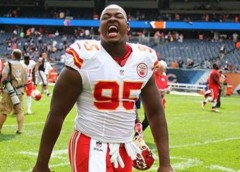The NFL has been around a long time and, with it, the 3-4 defense. The 3-4 is distinct for it‘s use of two-gapping, Nose Tackles, and more physical ILBs than the 4-3. At least it used to be. Changes in the NFL and college football aren’t so much stretching the definition of a 3-4 defense as changing it entirely. If you look at Chiefs roster construction, through the lens of a classic 3-4, it doesn’t make a lot of sense. Once you understand some of the new priorities for Sutton’s defense, though, it all becomes clear.
1. Sutton Doesn’t Use SILBs
On the face of it this statement is ludicrous. We’ve all seen two ILBs on the field at times, I’m not denying reality. What I am saying, is that Chiefs have stopped searching for the traditional run-stopping thumpers employed by the classic 3-4. If it looks like every ILB on the roster is better suited to play Mike (DJ’s position) than Will/SILB (Josh Mauga’s position), that’s because they are.
Why would Chiefs completely ignore a starting position on defense? They wouldn’t, but SILB is not a starting position anymore, it’s a sub package. The Chiefs, for a while now, have run far more nickel and dime sets than, what would be termed, their base defense. The very term ‘base defense’ has become a misnomer, because the Chiefs barely run it. The proof is in the snap counts. Outside of Derrick Johnson, the ILB with the most snaps was Daniel Sorenson. Ramik Wilson was a close second, but that’s at least partially because he took over as Mike when DJ got hurt. In 2015, Mauga had slightly more snaps than Husain Abdullah, but Abdullah was also splitting Spur (term for a S playing ILB) reps with Sorenson. In 2016, the Chiefs heaviest listed ILB was Derrick Johnson at 242. In the offseason, K.C. has had the opportunity to carry more ILBs than usual, but they’ve only added two, Eligwe (239lbs) and Cliett (222lbs). The days of the thumping SILB are gone. The Chiefs starters at ILB are Derrick Johnson and Daniel Sorenson. They’re are willing to employ some two ILB sets, but they aren’t going to carry players who can only operate well in a set that’s no longer their base defense.
2. NT Is Not a High Priority
When Dontari Poe hurt his back, many fans wondered if Chiefs would bring in a NT to replace him. They didn’t, instead, they had Jaye Howard bulk up a little bit and slide into that role. A classic 3-4 doesn’t work without a dominant NT. The NT’s ability to command a double team is crucial to the success of that system, but the Chiefs spend so much time in nickel and dime sets that NT is going the way of SILB. It’s well known, by now, that the Chiefs like to draft a player this year to replace a veteran next year. However, in preparing for Poe’s departure, Chiefs didn’t draft a NT, but rather a DE/DT in Chris Jones. Really this shouldn’t have been a huge surprise, because Poe’s biggest asset was his ability to bring pressure in dime fronts, something Jones can do as well, even though he doesn’t play the nose. Anymore… if a DL can play NT, it’s a feather in his cap, but if he can’t play DT, Sutton isn‘t interested.
3. The CB ‘Reliever‘ Is Here to Stay
In baseball, there are starting pitchers and relievers. Starters, pitch most of a game and can generally be trusted to be consistent over that span. Relievers might be really good for an inning or two, but they can’t be trusted beyond that. With the increased need for talented CBs in the NFL, Sutton has frequently employed a CB reliever of sorts. Players like Flemming, Cooper, Parker and Acker have all played some pretty good games at CB, though most haven’t stuck there long term. With the salary cap, most teams can’t afford more than three solid CBs. The “CB reliever” is an innovative solution. Put a young CB out there and teams don’t have any tape on him. You can plan your coverages to hide his weaknesses and, by the time other teams figure him out, your starter should be healthy again, or you can move on to the next reliever. It’s a smart way to get good production for little money. Unless the Chiefs really begin a rebuild in earnest, more CB relievers are probably around the “corner”, as Chiefs will need to save cap space going forward.
The NFL is always changing. Defense adjusts, then offense counter-adjusts, and so it goes… over and over. As more teams tune their defense to stop the passing game (like the Chiefs have) other teams will turn back to the running game. Since teams can’t hope to match up well against every offense or defense, versatility becomes king. Safeties who can play LB, LBs who can play both sides, and NTs who can play DT and pressure the QB will become coveted commodities. The Chiefs are ahead of the curve… for now. In a few years, if the power running game comes roaring back, they may need to get back to their roots and find a big mean SILB to clog up the middle. Then again, with the popularity of the spread offense in college, teams might not be able to field the talent necessary for a good power run game. That’s a story for another day though. Go Chiefs!


